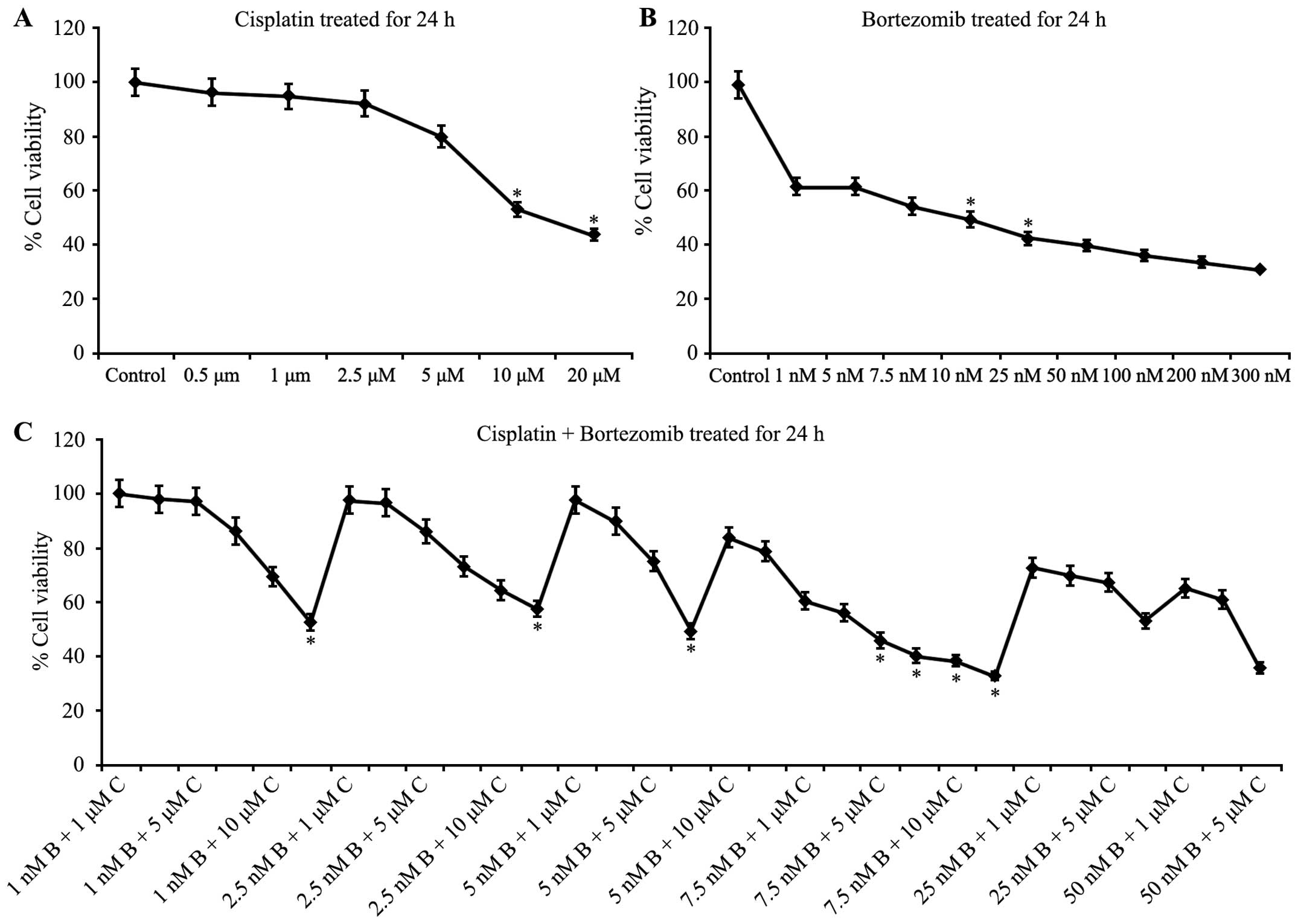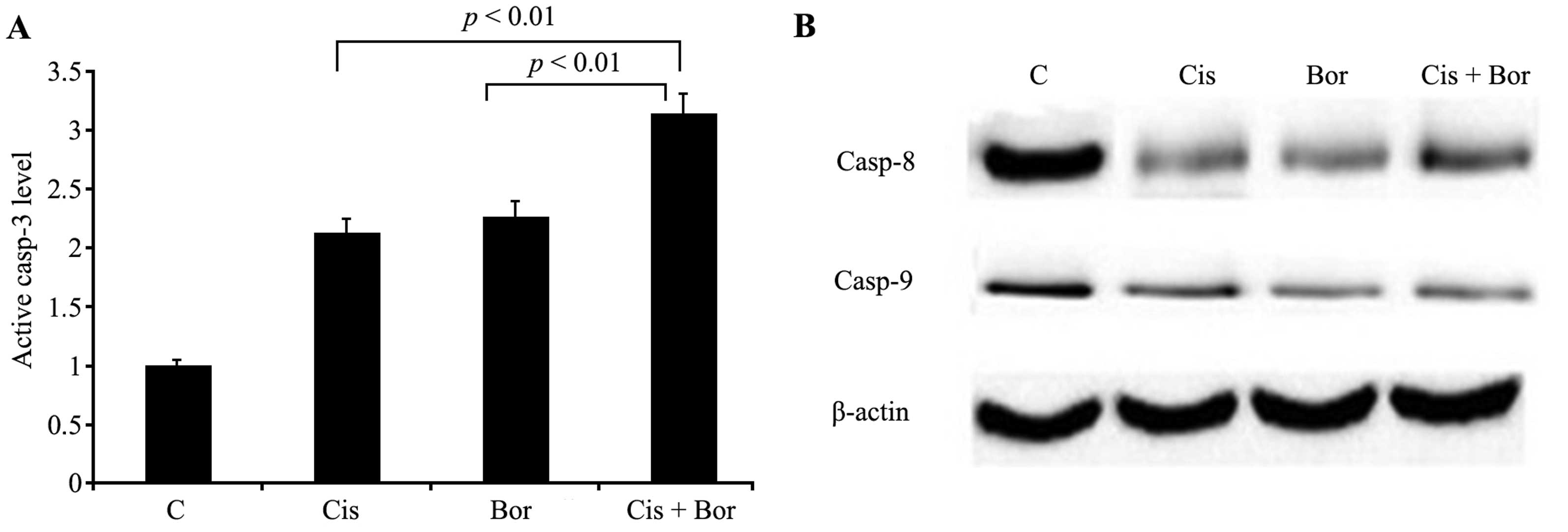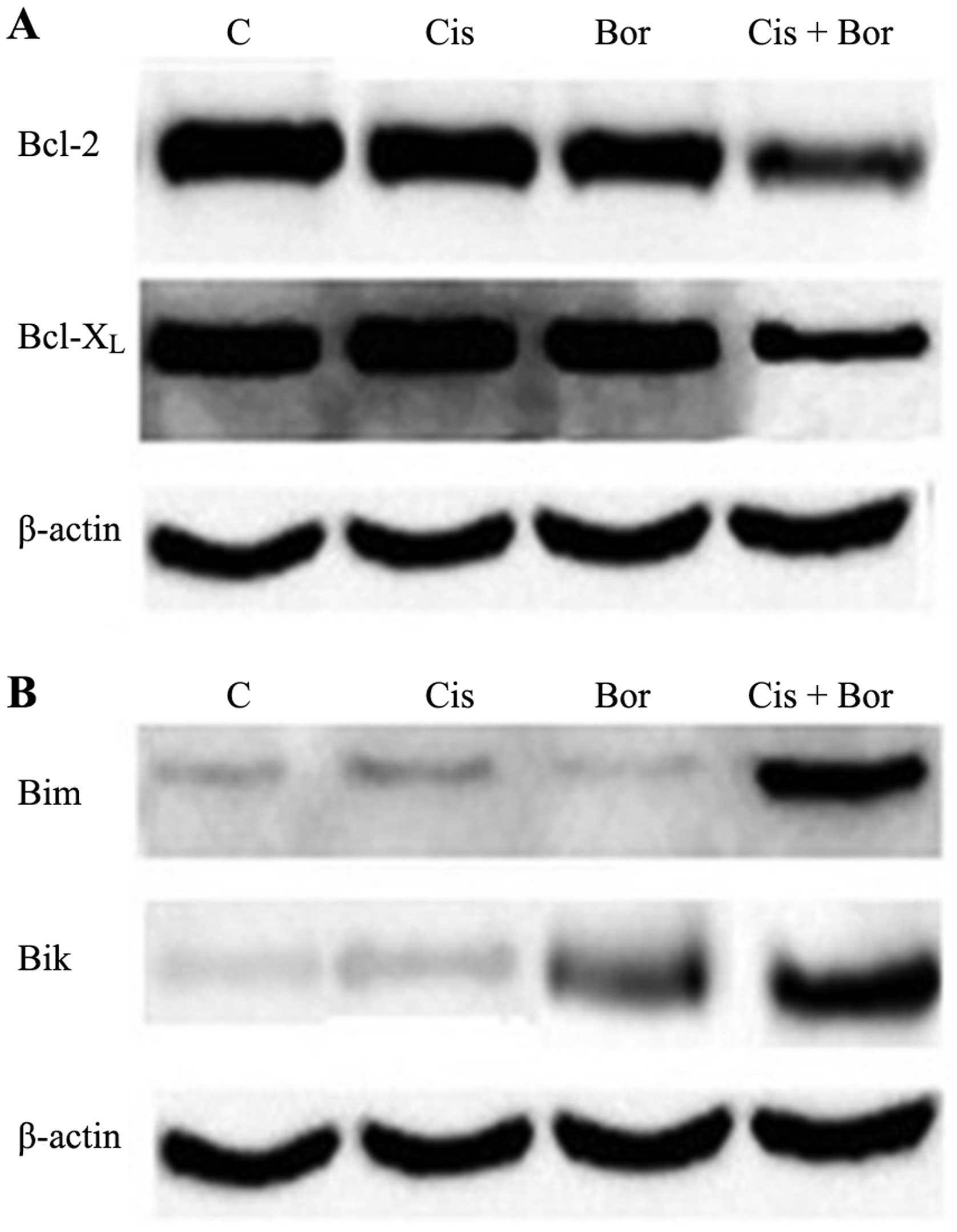|
1
|
Latini DM, Lerner SP, Wade SW, Lee DW and
Quale DZ: Bladder cancer detection, treatment and outcomes:
Opportunities and challenges. Urology. 75:334–339. 2010. View Article : Google Scholar : PubMed/NCBI
|
|
2
|
da Silva GN, de Castro Marcondes JP, de
Camargo EA, da Silva Passos Júnior GA, Sakamoto-Hojo ET and
Salvadori DM: Cell cycle arrest and apoptosis in TP53 subtypes of
bladder carcinoma cell lines treated with cisplatin and
gemcitabine. Exp Biol Med. 235:814–824. 2010. View Article : Google Scholar
|
|
3
|
Yu HM and Wang TC: Mechanism of cisplatin
resistance in human urothelial carcinoma cells. Food Chem Toxicol.
50:1226–1237. 2012. View Article : Google Scholar : PubMed/NCBI
|
|
4
|
Galluzzi L, Senovilla L, Vitale I, Michels
J, Martins I, Kepp O, Castedo M and Kroemer G: Molecular mechanisms
of cisplatin resistance. Oncogene. 31:1869–1883. 2012. View Article : Google Scholar : PubMed/NCBI
|
|
5
|
Köberle B, Tomicic MT, Usanova S and Kaina
B: Cisplatin resistance: Preclinical findings and clinical
implications. Biochim Biophys Acta. 1806:172–182. 2010.PubMed/NCBI
|
|
6
|
Cho HJ, Kim JK, Kim KD, et al:
Upregulation of Bcl-2 is associated with cisplatin-resistance via
inhibition of Bax translocation in human bladder cancer cells.
Cancer Lett. 237:56–66. 2006. View Article : Google Scholar : PubMed/NCBI
|
|
7
|
Li C, Li R, Grandis JR and Johnson DE:
Bortezomib induces apoptosis via Bim and Bik up-regulation and
synergizes with cisplatin in the killing of head and neck squamous
cell carcinoma cells. Mol Cancer Ther. 7:1647–1655. 2008.
View Article : Google Scholar : PubMed/NCBI
|
|
8
|
Al-Eisawi Z, Beale P, Chan C, Yu JQ and
Huq F: Carboplatin and oxaliplatin in sequenced combination with
bortezomib in ovarian tumour models. J Ovarian Res. 6:782013.
View Article : Google Scholar : PubMed/NCBI
|
|
9
|
Chen D, Frezza M, Schmitt S, Kanwar J and
Dou QP: Bortezomib as the first proteasome inhibitor anticancer
drug: Current status and future perspectives. Curr Cancer Drug
Targets. 11:239–253. 2011. View Article : Google Scholar : PubMed/NCBI
|
|
10
|
Hutter G, Rieken M, Pastore A, Weigert O,
Zimmermann Y, Weinkauf M, Hiddemann W and Dreyling M: The
proteasome inhibitor bortezomib targets cell cycle and apoptosis
and acts synergistically in a sequence dependent way with
chemotherapeutic agents in mantle cell lymphoma. Ann Hematol.
91:847–856. 2012. View Article : Google Scholar : PubMed/NCBI
|
|
11
|
Yang TM, Barbone D, Fennell DA and
Broaddus VC: Bcl-2 family proteins contribute to apoptotic
resistance in lung cancer multicellular spheroids. Am J Respir Cell
Mol Biol. 41:14–23. 2009. View Article : Google Scholar : PubMed/NCBI
|
|
12
|
Konac E, Varol N, Yilmaz A, Menevse S and
Sozen S: DNA methyltransferase inhibitor-mediated apoptosis in the
Wnt/β-catenin signal pathway in a renal cell carcinoma cell line.
Exp Biol Med (Maywood). 238:1009–1016. 2013. View Article : Google Scholar : PubMed/NCBI
|
|
13
|
Kamat AM, Karashima T, Davis DW, Lashinger
L, Bar-Eli M, Millikan R, Shen Y, Dinney CP and McConkey DJ: The
proteasome inhibitor bortezomib synergizes with gemcitabine to
block the growth of human 253JB-V bladder tumors in vivo. Mol
Cancer Ther. 3:279–290. 2004.PubMed/NCBI
|
|
14
|
Papageorgiou A, Kamat A, Benedict WF,
Dinney C and McConkey DJ: Combination therapy with IFN-alpha plus
bortezomib induces apoptosis and inhibits angiogenesis in human
bladder cancer cells. Mol Cancer Ther. 5:3032–3041. 2006.
View Article : Google Scholar : PubMed/NCBI
|
|
15
|
Qi W, White MC, Choi W, Guo C, Dinney C,
McConkey DJ and Siefker-Radtke A: Inhibition of inducible heat
shock protein-70 (hsp72) enhances bortezomib-induced cell death in
human bladder cancer cells. PLoS One. 8:e695092013. View Article : Google Scholar : PubMed/NCBI
|
|
16
|
Yerlikaya A, Altıkat S, Irmak R, Cavga FZ,
Kocacan SA and Boyaci I: Effect of bortezomib in combination with
cisplatin and 5 fluorouracil on 4T1 breast cancer cells. Mol Med
Rep. 8:277–281. 2013.PubMed/NCBI
|
|
17
|
Fribley AM, Evenchik B, Zeng Q, Park BK,
Guan JY, Zhang H, Hale TJ, Soengas MS, Kaufman RJ and Wang CY:
Proteasome inhibitor PS-341 induces apoptosis in
cisplatin-resistant squamous cell carcinoma cells by induction of
Noxa. J Biol Chem. 281:31440–31447. 2006. View Article : Google Scholar : PubMed/NCBI
|
|
18
|
Brozovic A, Ambriović-Ristov A and Osmak
M: The relationship between cisplatin-induced reactive oxygen
species, glutathione, and BCL-2 and resistance to cisplatin. Crit
Rev Toxicol. 40:347–359. 2010. View Article : Google Scholar : PubMed/NCBI
|
|
19
|
Rabik CA and Dolan ME: Molecular
mechanisms of resistance and toxicity associated with platinating
agents. Cancer Treat Rev. 33:9–23. 2007. View Article : Google Scholar : PubMed/NCBI
|
|
20
|
Hyman BT and Yuan J: Apoptotic and
non-apoptotic roles of caspases in neuronal physiology and
pathophysiology. Nat Rev Neurosci. 13:395–406. 2012. View Article : Google Scholar : PubMed/NCBI
|
|
21
|
Kim SY, Song X, Zhang L, Bartlett DL and
Lee YJ: Role of Bcl-xL/Beclin-1 in interplay between apoptosis and
autophagy in oxaliplatin and bortezomib-induced cell death. Biochem
Pharmacol. 88:178–188. 2014. View Article : Google Scholar : PubMed/NCBI
|
|
22
|
Krętowski R, Borzym-Kluczyk M and
Cechowska-Pasko M: Efficient induction of apoptosis by proteasome
inhibitor: Bortezomib in the human breast cancer cell line
MDA-MB-231. Mol Cell Biochem. 389:177–185. 2014. View Article : Google Scholar : PubMed/NCBI
|
|
23
|
Elkholi R, Floros KV and Chipuk JE: The
role of BH3-only proteins in tumor cell development, signaling, and
treatment. Genes Cancer. 2:523–537. 2011. View Article : Google Scholar : PubMed/NCBI
|
|
24
|
Fennell DA, Chacko A and Mutti L: BCL-2
family regulation by the 20S proteasome inhibitor bortezomib.
Oncogene. 27:1189–1197. 2008. View Article : Google Scholar : PubMed/NCBI
|
|
25
|
Neutzner A, Li S, Xu S and Karbowski M:
The ubiquitin/proteasome system-dependent control of mitochondrial
steps in apoptosis. Semin Cell Dev Biol. 23:499–508. 2012.
View Article : Google Scholar : PubMed/NCBI
|












